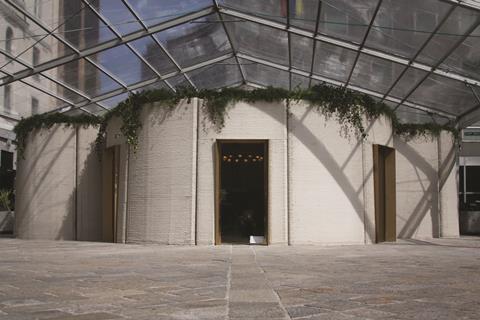- News

All the latest updates on building safety reformRegulations latest
- Focus
- Comment
- Programmes
- CPD
- Building the Future
- Jobs
- Data
- Subscribe
- Events

2024 events calendar
Explore now
Building Awards
Keep up to date
- Building Boardroom
Bring on the robots: the world's first 3D-printed house

It may still be sci-fi for some, but 3D printing is fast breaking down conventional barriers in engineering and architecture and changing the way the construction industry operates

Over the past few years the race to build the world’s first 3D-printed house has morphed from specialist sci-fi sideshow into one of the most compelling technological contests within the mainstream building industry. First off the blocks was Shanghai-based engineering company WinSun with its 3D-printed villa and flats in China’s Jiangsu Province in 2015. The five-storey, 1,100m² main building claimed to be the first 3D-printed block of flats in the world.
Next came the world’s first 3D-printed office in Dubai in 2016, again designed by WinSun in a collaboration with Gensler UK engineers Thornton Tomasetti and opened by none less than the prime minister of the United Arab Emirates. The single-storey 250m² structure was built in only 17 days and required a team of just seven installers and 10 specialist electricians to put together.
Europe’s first micro-home followed in Amsterdam in 2016, an 8m², 25m³ gabled cabin designed by Dutch practice DUS Architects. 2017 saw Europe’s first 3D-printed house, a 37m² one-bedroom structure in Moscow that was constructed using a mobile printing crane in just 24 hours. Designed by Russia and San Francisco-based 3D-printing specialists ApisCor, it cost just over £8,000 to build. And now Western Europe’s first 3D-printed house, 3D Housing 05, has opened in Milan.
Debuting last month at Milan’s design festival Salone del Mobile, the one-storey, 100m² showcase prototype has been built in a prestigious location in the piazza right in front of Milan’s famous cathedral and was unveiled by the city’s mayor.
Designed by Arup and Milanese architecture practice CLS Architetti, it embraces many of the same technological advances of its predecessors: it can be dismantled and relocated, takes just 48 hours to build and therefore represents significant cost and programme savings when compared with the construction of traditional housing.
…
Already registered? Login here
To continue enjoying Building.co.uk, sign up for free guest access
Existing subscriber? LOGIN
Stay at the forefront of thought leadership with news and analysis from award-winning journalists. Enjoy company features, CEO interviews, architectural reviews, technical project know-how and the latest innovations.
- Limited access to building.co.uk
- Breaking industry news as it happens
- Breaking, daily and weekly e-newsletters
Get your free guest access SIGN UP TODAY

Subscribe now for unlimited access
Subscribe to Building today and you will benefit from:
- Unlimited access to all stories including expert analysis and comment from industry leaders
- Our league tables, cost models and economics data
- Our online archive of over 10,000 articles
- Building magazine digital editions
- Building magazine print editions
- Printed/digital supplements
Subscribe now for unlimited access.
View our subscription options and join our community

















